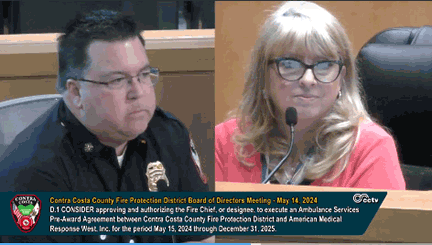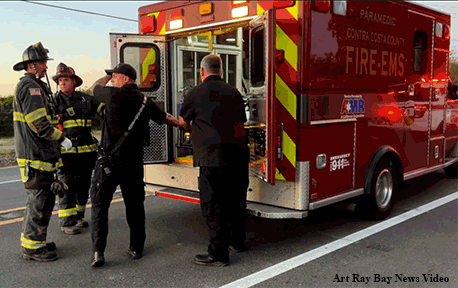In recent weeks, Contra Costa County EMS has been overloaded with incidents causing Ambulance Services to be reduced to Level 0 – no units available for transport — in Contra Costa County.
Level 0 occurs when multiple medical incidents are occurring at the same time or major multi-casualty events happen requiring multiple forms of resources and ambulances to a scene.
On Tuesday, the Contra Costa County Board of Supervisors took up the discussion seeking an explanation from Contra Costa County Fire Chief Lewis Broschard—this came under item D.1 where the Board was discussing a Ambulance Service Pre-Award Agreement with AMR. Broschard called it a system-wide problem that needs to be redesigned at every level.

Supervisor Diane Burgis questions Chief Brouschard over ambulance services
Supervisor Diane Burgis asked about ambulance service and the challenges over the weekend.
“There was a lot of concern expressed on social media and some assumptions made. Related to this, are we able to increase ambulance services under this situation and can you talk about the levels of service we have and what we have an agreement for and why there is not more ambulance services?,” asked Burgis.
Broschard called Saturday a challenging day for the system — noting they had multiple incidents at the same time and two mass causality responses.
“In my personal opinion, EMS is essentially at a crisis point. Not just in Contra Costa County but throughout the state and the nation,” explained Broschard noting others have more extreme challenges than Contra Costa County.
He said in September, the District increased the ambulances deployed from 54 per day to 70 per day—the basic life support ambulances of 16-18 are deployed in the system to try and decompress some of the 9-1-1 demand and hospital delays while saying its not getting much better.
“Certain days, I can’t say there is a pattern to this because we have looked and there are not distinct patterns, but Saturday was a day where the system got absolutely hammered and many instances in certain location, particularly in the east there were no ambulances available. The ambulances that may have been available were in the central core of the county or out west,” shared Broschard. “We call that level 0, meaning there are no ambulances available.”
Broschard said although they have increased the ambulances, attempting to find paramedics is nearly impossible—meaning they cannot increase the number of paramedic ambulances, but can increase basic life support (BLS).
“Right now we are transporting about 45-patients per day with Basic Life Support, and approximately 200-220 Advance Life Support (ALS) ambulances,” said Broschard. “Demand continues to increase.”
On May 9, he shared they had a kickoff meeting for “nurse navigation” to try and take 9-1-1 caller who is determined to not need an ambulance transport to an emergency room and get them service or help in some other fashion—noting its not widely used across the country, but being experimented with in some areas.
While noting the budget will take a hit with less people transported, but says “we are at a point where we have to do this”.
“The system is almost unsustainable from a logistics situation, not a funding or fiscal situation, its sustainability because there is not enough resources to keep up with demand,” explained Broschard. “We have also started to institute some off-load policies at hospitals. Meaning after a certain amount of time, we become more engaged with their staff to essentially work aggressively to get that patient transferred to the hospital. But that is around 60-minutes.”
He expalined the state standard is 20-mnutes 90% of the time while the county standard is 20-minutes 90% of the time since 2010.
“Nobody meets that at the hospitals,” says Broschard. “There is no entity we can find that can engage the hospitals to make system changes. Some hospital have done there own changes. Sutter Delta has done a couple of things and they have changed their issue tremendously from being the worst performer to the best performer. We hope to duplicate those.”
He again called Saturday not a good day for the system but guaranteed more days like Saturday will occur in the future but there are less days like Saturday than there were 6-months ago.
Burgis questioned when should people call 9-1-1 and call for an ambulance because there is a whole system of folks who need to learn how to use the system more efficiently, but it’s a system they are trying to deal with.
“Is there a reason why we should have more ambulances servicing or is this determined by population and how often do we get to Level 0?” asked Burgis.
“I think adding more to the system is just adding more. It’s not looking at the root causes and trying to find solutions,” stated Broschard who said there is no penalty for calling 9-1-1 so there is more demand than resources. “My analogy of adding ambulances is similar to widening a freeway, but they all end up at the same destination, they all end up at a hospital or hospital system that is overburdened, over-taxed, and under-staffed… the backup might be mitigated a little bit but the crash is still going to be there so you will all end up at the same spot. The system needs to be refined and changed from the very beginning.”
This included personal healthcare and engagement with primary care physicians to understand the 9-1-1 system.
He also said the Contra Costa County Mental Health Crisis team (A3) when fully staffed will help because the psychiatric calls are not transported by law enforcement, but rather ambulances—going one place, which is overburdened understaffed and has wait times of 90-to-120 minutes to offload a patient.
“To just add more ambulances, I don’t think we could even if we wanted to at this point,” said Broschard.
Here is the 10-minute conversation:
Supervisor Candace Andersen questioned if it was the hospitals to blame for Saturday or did everyone just get sick or have an emergency because we have to unload our patients quicker.
“More often than not, all of the above,” said Broschard noting during Level 0 events he looks at the notes and sees the delay which are “hospital delays” at every hospital which also shows some ambulances out of service which is not abnormal.
“When the system throws you 120 percent demand and you are staffed for 98 percent, there is no way to get through that other than just get through it,” explained Broschard. “At some point, the curve comes down.”
Broschard went onto explain it was the traditional factors of staffing, call volume at the time, impact at hospitals—if the hospitals are impacted, its not just because of the ambulances, they are only 15-20 percent of emergency room volume.
Supervisor Ken Carlson asked about mass casualty incident.
Broschard shared their contract allows them for wiggle room during these incidents but the outcome is the same—which occurred during the middle of the day Saturday which included multiple ambulances and two medical helicopters.
Contra Costa County Item D.1:
According to Fire Chief Lewis Broschard, it’s a duplicate of what they had been doing for 10-years (the alliance is Contra Costa County Fire and AMR since 2016). The item executes ambulance service to the county.
“The award is referring to the potential award by the county to the district for ambulance services through the competitive RFP process,” stated Broschard. “This agreement is between the District and AMR who was selected as our prospective sub-contractor.”
Last summer, there were 3-firms who showed up to bid which included AMR, Priority and Royal Ambulance. Through competitive process and assessment panels, AMR was determined to be most qualified. They then entered into an agreement to negotiate the concept of an agreement based on current form of contract between the District and County.
“This is step 1 to identify a contractor for the District to move forward in the RFP process with the county,” explained Broschard noting the county has to allow for the RFP and AMR has to win the RFP… the alliance version 2.0”.
Broschard said more information would come later with costs or services offered. He did say an agreement in the future could be around $300 million over 5-years.
To view the full meeting, click here.


4 comments
I listen to the fire scanner all the time. People really need to learn when to call 911. Two stupid 911 call examples. Both in their 20’s. One had a tooth ache from a cavity. One had a sore throat. Really? There are calls like that all the time. To all the First Responders, thank you for all you do. I appreciate you all and pray for you all every day.
Ambulance jobs sucks that’s why no one wants to be a paramedic. Pay them more.
This is on AMR mgmt.
They continue to run their crews into the ground as wall delays continue and staffing continues to be a challenge.
No one should look at AMR as a career. They prefer that employees leave for fire so they may hire cheaper employees at step 1 on the pay scale.
They need to start by removing Chad from his position.
He has obviously forgotten where he came from.
My grandson loves being an EMT for AMR. He makes 1 dollar more than fast food workers. He has 6 roommates.
Comments are closed.